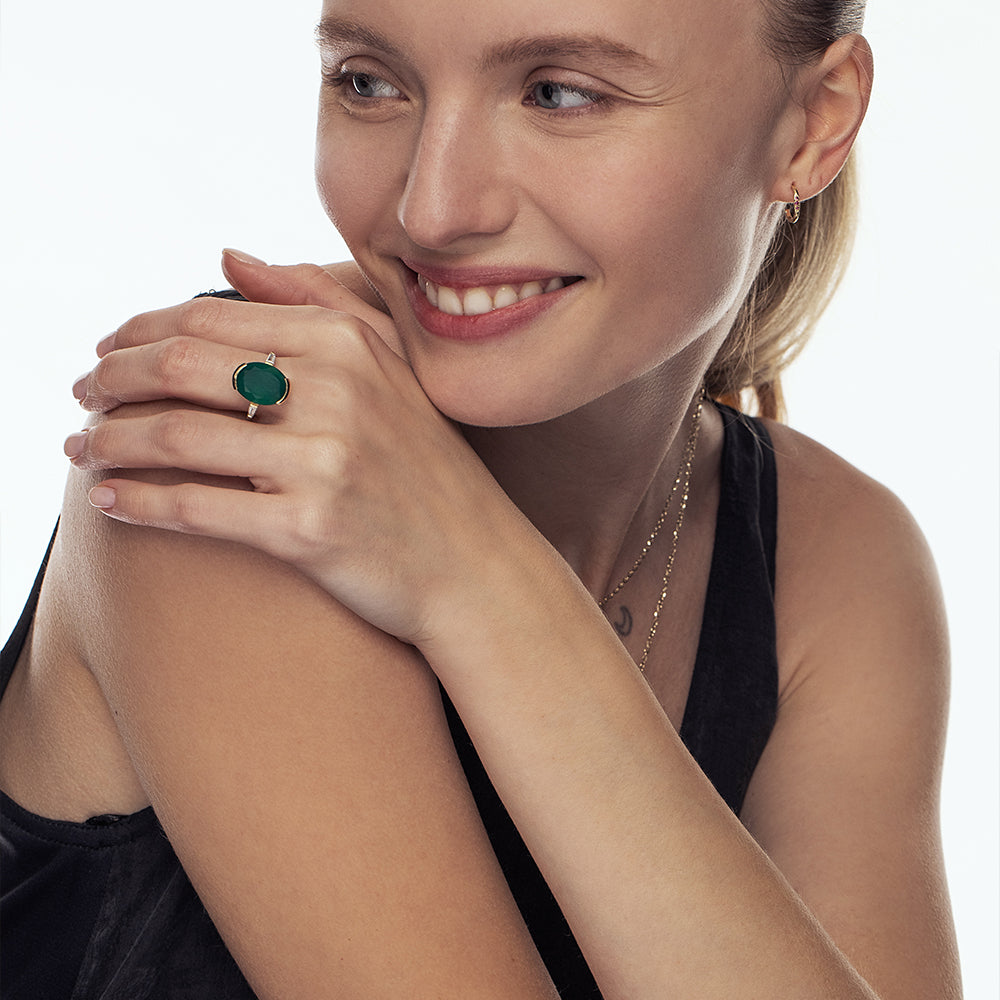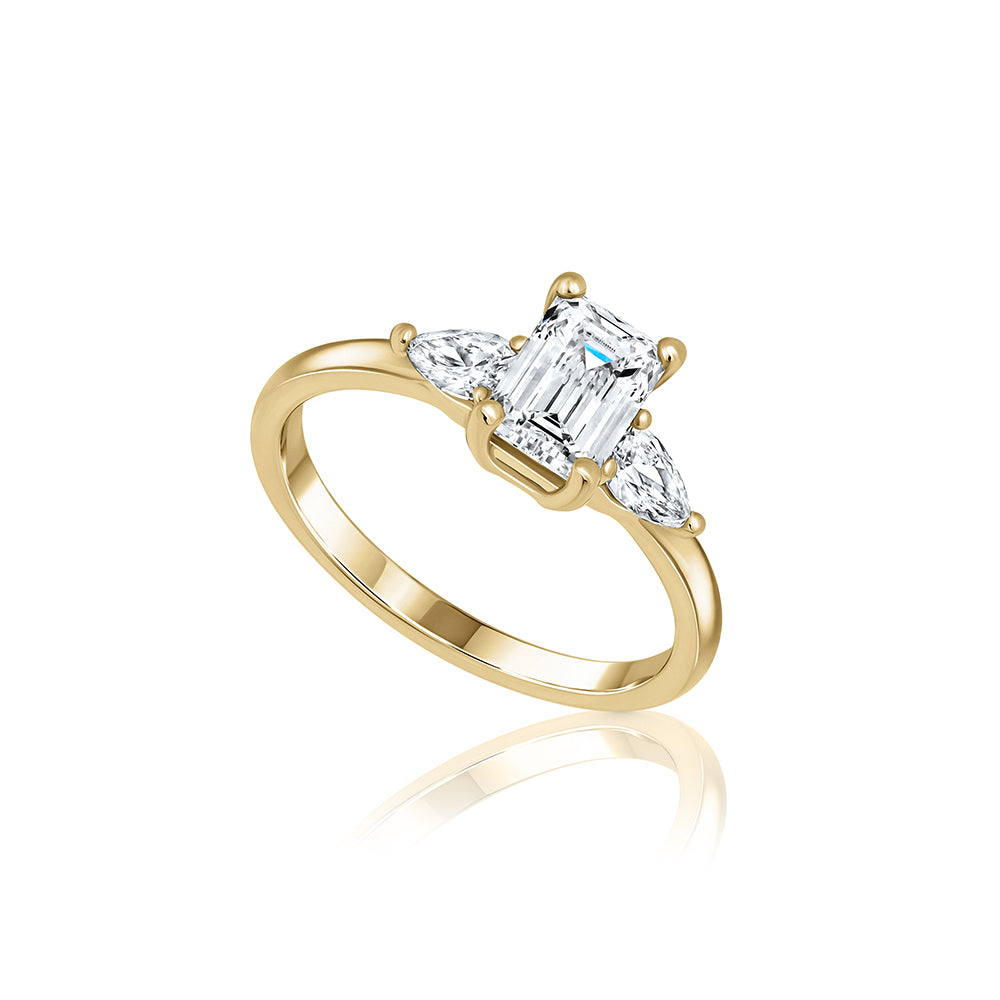Diamond shapes and cut types
Do you also find yourself looking for a piece of jewelry set with diamonds, scrolling through spectacular jewelry, reading the information about the shape of the diamond and its type of cut, but not fully understanding what it is? So we're here to clear things up for you.
If you love diamonds (and who doesn't?), and want to know more about diamond shapes and cut types, keep reading.
Different shapes of diamonds
Popular diamond shapes
When we talk about the shape of a diamond, we are referring to its geometric appearance. Diamond shapes are classified into two main types of diamonds:
Type 1: A round, brilliant diamond, considered the most traditional and popular shape for setting in engagement rings.
Type 2: A diamond in a shape other than round, such as:

What characterizes each diamond shape?
The shape of the diamond has a great impact on the beauty of gold rings and engagement rings. For a delicate gold ring to present its best aesthetics, the lines of the diamond shape should reflect the shape of the engagement ring or vice versa.
In general, a round diamond is the most traditional and popular choice for engagement rings. Although there is also a lot of appreciation today for engagement rings with sapphires or other non-diamond gemstones. The next most popular shapes, after the round, are the cushion and oval. Although historically the princess cut has been the second most popular, in the last decade, the cushion and oval diamonds have begun to overtake the princess cut.
- A round shape offers a shape that is simply perfect. It is a shape that allows the most light to be reflected back to the eyes, so that the diamond will look the most sparkling in the world. Round diamond shapes are versatile and come in a variety of shapes and diamond settings.
- The cushion shape comes in a square or rectangle. It is a soft and unique shape, suitable for designing delicate gold rings or custom engagement rings , with cushion-shaped diamonds set in a stunning halo setting.
- The oval shape is a very popular diamond shape when set in vintage-style custom engagement rings. An oval-shaped diamond is also a popular choice for delicate 3-stone engagement rings , with one gemstone sandwiched between two diamonds, creating a particularly striking and striking design.
- Princess cut diamonds offer a diamond shape that is considered one of the more luxurious types of diamonds. Gold rings set with princess cut diamonds feature diamonds with pointed corners that create a dramatic effect defined as an extraordinary sparkle of fire. Princess cut diamonds can come in a square or rectangular shape.
- The Emerald shape offers a highly sought-after diamond due to the fact that it reflects a radiance and depth that attracts the eye. The emerald diamond, which is shaped like an octagon (an 8-sided polygon), creates a unique diamond quality. This shape is made up of parallelograms and rectangles and reflects the full pure and clear beauty embedded in the diamond. The emerald diamond is the ultimate choice for people looking for special gold rings or engagement rings inspired by the style that characterizes Art Deco.
- A pear shape combines the round, brilliant style with the princess cut, creating a pointed drop that displays the light in an exceptional way. Like oval and princess diamonds, the finger-lengthening drop shape is especially flattering when the tip of the drop points toward the nail, rather than the other way around. Teardrop diamonds reflect precise symmetry and are especially beautiful when set as a halo in a gold ring.
- Heart shape offers a diamond shape that classically symbolizes love. This shape maintains a precise ratio between the length and width of the heart, ensuring perfectly symmetrical curves that create the heart shape. A heart-shaped diamond is an excellent choice for classic romantics who are particularly drawn to sentimental and rare gold jewelry .
- The Asscher cut creates a square diamond. Unlike the princess cut, which is square, Asscher diamonds resemble a style called step cut facets. This is a method of processing the stone when it is flat and includes a kind of steps on all four sides, which are cut parallel to the “girdle,” the widest part of the top of the stone. This shape creates optical properties that appear like a “hall of mirrors,” making this diamond shape magical and unique.

What are the different types of diamond cuts?
There are three types of diamond cuts:
Brilliant cut diamond
A brilliant cut involves arranging the diamond's surface to maximize its brilliance. This cut has triangle and kite shapes that extend outward from the center, creating a prism-like reflection of light.
Brilliant diamond cuts are standard and are only used for cutting a diamond that is round in shape. There is another type of Brilliant cut called Modified Brilliant, which refers to any Brilliant cut of a diamond that is not round in shape.
Step cut
A step cut diamond creates a rectangular surface that runs parallel to the top ‘belt’ of the diamond. The large, linear surface of the diamond reflects light like a ‘hall of mirrors’. Of all the diamond cuts, and especially compared to the brilliant cut, the step cut has less fire and sparkle, mainly because of the shallow area where the diamond crown is located and the surface area (pavilion) below it. Because of the structure created by the step cut, it allows the clarity and color of the diamond to be emphasized.
Mixed cut
A mixed cut combines two types of cuts: Brilliant and Step. The crown of the diamond is usually cut in a Brilliant cut, and the surface below it (the Pavilion) is cut in a Step cut. This combination of the two cuts creates a crushed ice effect when light is reflected from it.

How do you grade the quality of diamonds based on their cut?
To assess the quality of diamonds and determine their types and prices, they are graded according to the quality of their cut. The cut grade is based on the universal GIA (The Gemological Institute of America) system. The cut grade is determined after examining the amount of light that is able to enter and exit the diamond.
All diamonds are graded into these five cut grades:
- Excellent
- Very good
- Good
- Fair (fairly good)
- Poor
Two additional cut grades, above the 'Excellent' grade, are used to evaluate round cut diamonds: Ideal and Ideal + Hearts (the best cut grade). The higher the cut grade, the better the quality of the diamond.
What is the difference between diamond shape and diamond cut?
People often confuse the two terms: ‘diamond shape’ versus ‘diamond cut.’ But these are two different terms. In fact, the way a diamond is cut determines its shape.
Diamond shape – This term refers to the geometric appearance of the stone, that is, its silhouette.
Diamond cut – This term refers to the surface structure of the diamond, with the cut depending on the shape of the diamond. Diamond quality is graded according to three categories: overall cut, symmetry, and polish.
In fact, the quality of a diamond is not assessed by its shape, but only by its overall cut, symmetry, and polish!
Did you know?
- The largest diamond in the world is the Cullinan diamond, discovered in 1905 at the Premier mine in South Africa, and named after the mine owner, Thomas Cullinan. The diamond was estimated to weigh 3,106 carats and 0.6 kg. This magnificent diamond is part of the British Crown Jewels. The diamond was cut from a very large stone that, since its discovery, is still considered the largest rough gemstone ever found in the world.
- The most expensive diamond in the world is the Kohinoor diamond. This diamond is colorless, oval in shape, and weighs 105.6 carats. The Kohinoor diamond is one of the largest cut diamonds ever discovered, and its history is long and fascinating. It is said that this diamond was mined centuries ago in the Kollur mine in India, and passed through several owners before coming into the possession of Queen Victoria. Many people believe that the Kohinoor diamond was stolen from India by the British.
The Koh-i-Noor diamond is considered to bring terrible luck to men. And since it was brought to Britain, only the royal family has worn it. Today, the Koh-i-Noor is one of the many diamonds that make up the crown of the Queen Mother, who passed away in September 2022, and is included in the British Crown Jewels collection.
And although we mentioned that it is the most expensive diamond in the world, the truth is that it is such a rare stone that its actual value is virtually unknown. Fortunately, the issue of the price of the Kohinoor diamond did not come up, because it is always traded, stolen or given as a gift, and it has never been recorded that it was sold to anyone.
Written by סתיו דוידוביץ






